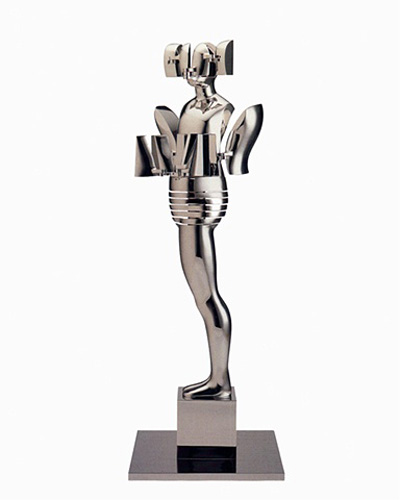
 Sculpture News at SculptSite.com
Sculpture News at SculptSite.com
Ernest Trova Sculpture |
| ST. LOUIS POST-DISPATCH BY CALVIN WILSON A new look at Ernest TrovaErnest Trova, an artist best known for his "Falling Man" series of paintings and sculptures, rose to the heights of the New York art world without becoming a New Yorker. He pulled off the rare feat of achieving fame without leaving St. Louis. But when he died last year at age 82 at his home in Richmond Heights, Trova's reputation as a national figure had fallen into question. Although his work continues to be held in high esteem locally - his sculptures may be seen in public places and he donated about 40 works to Laumeier Sculpture Park - an obituary in The New York Times noted that Trova's profile "went into decline" beginning in the mid-1980s. And at least one prominent textbook deleted a reference to the artist between editions. But "Ernest Trova," a new exhibition at White Flag Projects through July 17, makes the case that Trova was a significant figure in American art and that his work deserves to be viewed in that light. "It became apparent after he passed away that none of the other institutions in town - large institutions that, I think, had more space and resources - were going to be interested in doing anything," said Matthew Strauss, director of the art gallery and a close professional associate of Trova. The exhibition includes 16 pieces, some of them featuring the "Falling Man" - a futuristic, armless figure - that was Trova's signature image. The figure became so popular that Trova's detractors accused him of commercialism. But his proponents considered the "Falling Man" repetitions as artistically valid. In effect, Trova's aesthetic represented an intriguing synthesis of "very new and very classical" influences, Strauss said. "Within an art-historical linear narrative, he was seen - I think, reasonably - as being a branch of (Swiss sculptor Alberto) Giacometti," he said. And Trova's work "touched on all these interesting reference points without landing firmly in any of them." "Yes, it has some degree of futurism," Strauss said. "Yes, it has some degree of surrealism. Yes, it has some degree of almost minimalism in a way - although minimalism is not very apt, and neither is Pop Art. It never shifted the art world, but I think Trova should be on the same level, certainly, as someone like Robert Indiana (who is best known for creating the iconic 'LOVE' sculpture)." Trova was born in Clayton in 1927. He was only 20 when he had his first big success: His painting "Roman Boy" won first prize in the Missouri Exhibition at the City Art Museum (now the St. Louis Art Museum). In 1949, Trova took a trip to New York, seeking out and spending time with one of his influences, abstract expressionist painter Willem de Kooning. By the 1960s, Trova was being represented by New York's prestigious Pace Gallery (now PaceWildenstein). Trova was not only an artist, but also "a funny, funny person," Strauss said. "Once you get past the surface, and once you get past the allure of how he tended to work with materials, there's this underlying vein of really dark humor that is invested in each one of these objects," he said. "And hopefully, it demonstrates some sense of what he was like personally." That humor is quite evident, Strauss said, in a 1954 painting called "Berick." "It's a painting he made very shortly after returning from New York, after his studio time with De Kooning," he said. "It's essentially a very de Kooning-esque painting, but it's got a dog's head instead of a woman's head." In addition to the exhibition, White Flag Projects has established etrova.org as an ongoing resource on the artist. "As we were organizing the exhibition, we realized that, unlike every (other) artist we've ever dealt with - and we've had a hundred-odd artists come through here - Trova had no Web presence," Strauss said. "And it occurred to us that not only did he not have a website, but what was on the Web were (sites) that did not show his work in a reasonable way - so you image-searched Trova and came up with all this garbage." In contrast, etrova.org is intended to "present his work more broadly and more favorably. Instead of doing a catalog, which we didn't have enough money for, we decided that a website would actually serve nearly as good a purpose and would be more democratically available." It's just another effort to help restore the reputation of a worthy artist, who may have damaged his career when he parted with the Pace Gallery in the mid-1980s and signed with a St. Louis dealer. An image of Trova's sculpture, "Study/Falling Man (Carman), 1966," was included in the third edition of the widely used textbook, "History of Modern Art" in 1986 - but was subsequently dropped in 1998, Strauss said. "It's not in the fourth edition - or the fifth edition," he said. |
 Gone but not forgotten... Thanks go to Matthew Strauss, the White Flag Projects and Calvin Wilson for bringing Ernest Trova to us again. His 'Falling Man' pieces are so significant. Please visit the website to see and learn so much more about the man and his work www.etrova.org |
 Study "Falling Man" (multiple hinge figure) by Ernest Trova |
More Sculpture News ....
Submit your SCULPTURE NEWS.
It's easy, just send us an e-mail
(click on Submit News in the left menu) with your pertinent information along with images, we'll take care of the rest. Sculpture makes our world a much better place in so many ways!
SculptSite.com, along with Sculptors and their creative genius all helping to bring the beauty and message of Sculpture to a hurried world.

